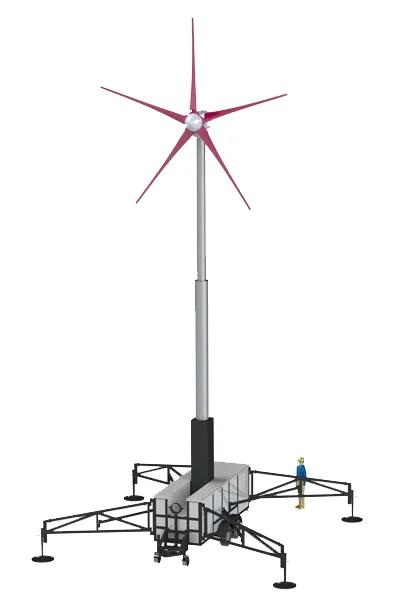
Benefits of Hybrid Energy Solution: Wind + Solar + Storage
info@upriseenergy.com
info@upriseenergy.com

Wind + Solar + Storage
Benefits of a Hybrid Energy Solution
Fortunately, there have been significant technological advancements in the energy space that give promise to fulfilling this need.
At the forefront of renewable energy development is solar power and wind power. Again, neither hold the answer on their own but collectively the two compliment one another nicely. The third, and critical element of this equation is energy storage, where again, there have been considerable improvements made in recent years, with significant headroom for future development.
The following narrative demonstrates the benefits of a hybrid energy system where the principal components, solar panels and wind turbines, work in conjunction with energy storage.
Due to limited sunlight hours during the day, a solar system designed to provide 24 hours worth of power must generate that in approximately 1/5 of the day. Therefore, the system would need to generate enough power in ~5 hours to last 24, with the ability to store at least 19 hours worth of energy.
When a wind machine that can make power around the clock is added to the solar system, the size of the solar and, more importantly, the storage system can be dramatically reduced, resulting in lower cost with higher energy density and a smaller carbon footprint (fewer chemical batteries = good for the environment).
In fact, when a wind machine is added to a solar system, the size and cost of that solar system and its storage system will be reduced to a point where the savings equal or exceed the cost of the wind machine.
To illustrate this point, if we look at a hypothetical model that needs to generate and deliver an average of 20+ kW per hour, or approx 500 kWh per day, here are a couple potential scenarios using just solar + storage, and solar + wind + storage:
In the solar + storage scenario, the solar system would need to make 500 kWh in 5 hours, and therefore, must average over 100 kWh per hour. At 250 watts per panel, this amounts to 400 panels at $300 each = $120,000.
Assuming this is an off-grid installation, all of the power would need to be stored so it can be released overtime, including after the sun goes down, as the demand requires. Therefore, at $500 per kWh of battery of storage, 500 kWh = $250,000
If a wind machine provides 20% of the power needed over the 24 hour cycle, then the cost of solar and storage can be reduced by 20%, or 20% of $370,000, which amounts to $74,000. This is the calculus when the wind speed is low and the wind machine is only making 4 kW per hour.
If the wind speed increases from 5.4 m/s (12 mph) to 7.2 m/s (16 mph), the wind machine will produce ~8 kWh or ~200 kWh per day.
The calculus is better and results in a 40% reduction in the solar system and storage. In this case, a single Uprise wind machine that costs $80,000, will reduce the cost in this model by 40%, which is equal to $148,000, much more than the cost of the wind machine.
When combining solar, wind and storage, there are other factors that come into play depending on the blend of local conditions of sun, wind, rain, clouds, etc.
When the sun is strong and temperatures are high, wind tends to be weak.
Conversely, when wind is strong and skies are cloudy with rain and moisture, sunlight is minimal.
Therefore, a combination of wind and solar will likely increase energy production during any cycle.
Solar power is low in density, requiring large surface areas. Installations require site improvements and lengthy transmission lines. Solar systems are not portable and in order to maximize energy capture throughout the day and over the seasons, must incorporate azimuth tracking at additional expense. If not, then seasonal performance will vary, and customer needs may be curtailed.

Uprise Energy • Mobile Power Station
Portability has its advantage.
The Uprise wind machine can be easily transported, fully assembled without site improvements, all by one person in one hour, and can be relocated easily.
It can operate in parallel, with any voltage and frequency system, or can operate in a stand alone configuration and store energy when consumer needs are less than energy capture rates.
The Uprise wind machine is very power dense in comparison to a solar system.
Even though we rate the Mobile Power Station at 10 kW in an 8 m/s (18 mph) wind, when a wind gust of 16 m/s (36 mph) blows thru (and as a result of the exponential power rule in wind), the power generated by the Uprise wind machine will burst to 80 kW.
While this exceeds the constant power rating, it does not exceed momentary burst capture capacity. Due to the dancing with the wind feature, these electrons can be captured and stored.
A solar system does not have this burst capacity.
When a solar system is installed it may not meet current or future energy power needs.
Rather than increase the capacity of the solar system, an Uprise wind machine can be delivered to the site and within hours, increase energy capture and storage, and power delivery to the consumer.
This can be done again and again, meeting peak demand, and then redeployed to operate elsewhere until seasonal or weather cycles create short term needs.
There are billions that live and work at the grid's edge and beyond. Many of these people suffer without access to reliable power. If the power grid extended to all parts of the globe, this would not be an issue, but it doesn't and it never will because it's so expensive to install, which, using US numbers, averages $50,000 per mile.
Thankfully, with advancements in renewable energy designed for distributed generation, like the Mobile Power Station, along with the scenarios described above, there are feasible solutions for these markets that are not reliant of fossil fuels or a utility power grid.